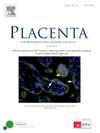羊水中的催尿素是一种有用的临床炎症生物标志物,可用于组织学羊膜炎的产前预测诊断:一项回顾性初步研究
IF 3
2区 医学
Q2 DEVELOPMENTAL BIOLOGY
引用次数: 0
摘要
摘要本研究探讨羊水中尿前压素是否可作为组织学羊膜炎(HC)产前预测诊断的一种有用的炎症生物标志物。方法对38例怀疑有宫内感染的单胎孕妇进行回顾性研究。所有患者均行羊膜穿刺术,测定羊水中前尿素(P-SEP)、白细胞介素-8 (IL-8)和白细胞介素-6 (IL-6)水平。在Blanc分类的各个阶段评估P-SEP、IL-8和IL-6的浓度,并评估浓度之间的相关性。根据HC的存在与否将患者分为两组,HC的预测因素采用结合母体白细胞计数(WBC)、母体c反应蛋白水平(CRP)和P-SEP的logistic回归模型进行评估。结果Blanc病Ⅱ期(p = 0.0219)和Ⅲ期(p = 0.0262) p - sep浓度显著高于Blanc病0期(p = 0.0262)。p - sep浓度与IL-8 (p = 0.0001)、IL-6 (p <;0.0001)。多变量分析显示,WBC(优势比(OR), 1.27;95%可信区间(CI), 1.03-1.68), CRP (OR, 1.13;95% CI, 0.87-1.58), P-SEP (OR, 1.12;95% CI(1.00-1.28)为HC的显著预测因子。P-SEP可在羊水及母体生物标志物联合检测,P-SEP对HC的预测具有较高的准确性。因此,我们的数据为怀疑宫内感染的患者早期产前检测HC提供了相关信息。本文章由计算机程序翻译,如有差异,请以英文原文为准。
Presepsin in the amniotic fluid is a useful clinical inflammatory biomarker for the prenatal predictive diagnosis of histologic chorioamnionitis: a retrospective preliminary study
Introduction
This study investigated whether presepsin in the amniotic fluid is a useful inflammatory biomarker for the prenatal predictive diagnose of histologic chorioamnionitis (HC).
Methods
This retrospective study included 38 singleton pregnant women who were suspected of having an intrauterine infection. All patients underwent amniocentesis and amniotic fluid levels of presepsin (P-SEP), interleukin-8 (IL-8), and interleukin-6 (IL-6) were measured. Concentrations of P-SEP, IL-8, and IL-6 were evaluated for each stage of Blanc's classifications, and correlations between the concentrations were evaluated. Patients were divided into two groups based on the presence or absence of HC and predictors of HC were assessed using a logistic regression model with a combination of maternal white blood cell count (WBC) and maternal C-reactive protein level (CRP) and P-SEP.
Results
The concentrations of P-SEP for Blanc's Stage Ⅱ (p = 0.0219) and Stage Ⅲ (p = 0.0262) were significantly higher than those for Blanc's Stage 0. The concentration of P-SEP correlated significantly with that of IL-8 (p = 0.0001) and IL-6 (p < 0.0001). Multivariable analysis showed that WBC (odds ratio (OR), 1.27; 95 % confidence interval (CI), 1.03–1.68), CRP (OR, 1.13; 95 % CI, 0.87–1.58), and P-SEP (OR, 1.12; 95 % CI, 1.00–1.28) were significant predictors of HC.
Discussion
P-SEP can be measured in the amniotic fluid and a combination of maternal biomarkers, and P-SEP can predict HC with high accuracy. Therefore, our data provide relevant information to support the early prenatal detection of HC in patients with a suspected intrauterine infection.
求助全文
通过发布文献求助,成功后即可免费获取论文全文。
去求助
来源期刊

Placenta
医学-发育生物学
CiteScore
6.30
自引率
10.50%
发文量
391
审稿时长
78 days
期刊介绍:
Placenta publishes high-quality original articles and invited topical reviews on all aspects of human and animal placentation, and the interactions between the mother, the placenta and fetal development. Topics covered include evolution, development, genetics and epigenetics, stem cells, metabolism, transport, immunology, pathology, pharmacology, cell and molecular biology, and developmental programming. The Editors welcome studies on implantation and the endometrium, comparative placentation, the uterine and umbilical circulations, the relationship between fetal and placental development, clinical aspects of altered placental development or function, the placental membranes, the influence of paternal factors on placental development or function, and the assessment of biomarkers of placental disorders.
 求助内容:
求助内容: 应助结果提醒方式:
应助结果提醒方式:


